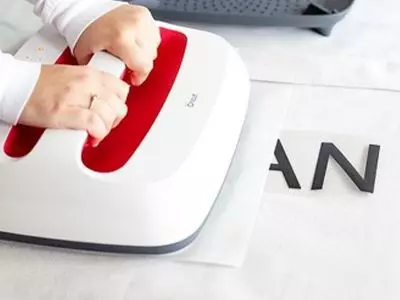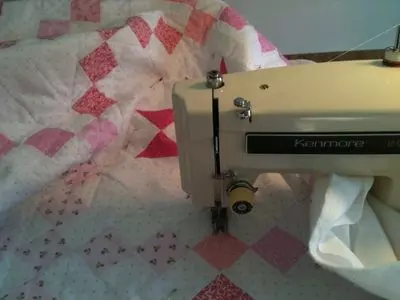The Cricut Heat Press and your regular household iron can both be used for your iron-on projects, but does one perform better than the other?
And if you have an iron, do you really need a Cricut Heat Press?
Here’s a detailed comparison of the Cricut Heat Press vs iron and why we think you should use both for your t-shirts, banners, blankets, and other homemade crafts!
Cricut Heat Presses

A Cricut heat press is an accessory that allows you to press on materials such as iron-on vinyl, glitter vinyl, and other materials.
The Cricut heat press can apply heat to emboss or deboss text or images, and make transfers.
The removable plate with its silicone surface will hold your printed material without slipping, ripping, or damaging the table surface.
The Cricut Heat Press fixture can also be used with embossing and debossing papers.
The Cricut heat press adds iron-ons to any designed project, like blankets, clothing, hats, shoes, and banners. You can even do sublimation with easy press!
The heat press can heat up to 400 degrees Fahrenheit, allowing you to make hot enamel designs on glass items that can be durable and wear-resistant.
Here are some notable features of the heat press:
- Various plate sizes for easier ironing on larger and smaller designs
- Perfect for multiple crafts in a short amount of time such as making shirts
- High temperature allows for a perfectly adhered project
Read our related article on How to Use Cricut Easypress Mini. The Mini is perfect for petite projects and a BREEZE to use. Here’s a quick tutorial!
Household Irons
There are many kinds of irons to choose from, such as steam press, ceramic, or dry irons.
The silent steam model helps control dust particles and allows for easier pressing of clothes and other fabrics.
The ceramic steam models are made from ceramic. This unique material produces steam that reaches up to 400 degrees Fahrenheit.
Here are some notable features of a regular home iron:
- Easily accessible and much cheaper than most heat presses
- Gets hot enough to adhere your project well to the material
- Easier to control when ironing edges of a design
How can Cricut Heat Press and Irons be used?
Both an iron and a Cricut Heat Press can be used to adhere iron-ons to your projects.
Generally, there is one size of a household iron, which means that it may not be convenient to use on all projects.
The Cricut Heat Press is available in different sizes, making it more universal for variously sized crafts.
You can also use a heat press and iron for one project if you want to have larger and smaller images on the same material.
Here’s a great video demonstrating the difference between a heat press and iron:
Cricut Heat Press Pros and Cons
Pros
- With a Cricut heat-press, you can do multiple projects simultaneously because it’s easy to remove and attach it again for another design job.
- It’s a quick way to make fast designs on your fabric projects like shirts, dishcloths, potholders, pillowcases, or table linens.
- Any fabric that is flat is perfect for using a heat press on.
- Overall, a Cricut Heat Press is more efficient than an iron, as it heats up both sides of the material for an effortless adhesion of your design or lettering.
- A heat press does the adhering quickly and makes it last longer than other methods.
Cons
- Heat presses are definitely not the best option for projects like hats, and shoes.
- If you’re making a project that is very large, it can be a bit awkward to fit it on the plates.
- Unless you get a mini heat press, it will take up more room than a household iron, so you’ll need some storage space if you go for a heat press.
Iron Pros and Cons
Pros
- Household irons are a bit more versatile than a heat press because they’re hand-held and can be maneuvered over projects that aren’t flat.
- Irons can be great for designs on shoes, hats, and other rounded materials. It’s also a great option for smaller flat projects, like custom onesies.
- They’re also really easy to store and serve multiple purposes around the house.
Cons
- With an iron, you’ll have to flip the material over and heat the other side manually if you want to get good adhesion.
- While an iron certainly works, it does take a bit more effort to get it to adhere properly.
- You’ll also experience cold and hot spots on an iron, which could cause your iron-on to bubble or not stick right in some places.
Cricut Heat Press vs Iron – Which is Right for you?

The Cricut heat press and the iron are both great for different projects, and we really think you could use both if you’re a serious crafter.
That said, the heat press is made to reduce your time spent on any particular project, whether it involves making table linens, pillowcases, or shirts.
If you need to quickly create specialty items such as table linens or kitchen towels, you’ll love using a heat press.
On the other hand, an iron is super versatile, small, and ideal for projects that are a little trickier.
Our recommendation? Use both! You likely already have an iron in your laundry room, and a heat press is a great addition to your craft room.
You’ll be able to expand the projects you can create with an iron and a heat press.
Which is Better for quilts?

This is a little tricky because quilts are generally pretty big.
It can be a bit wonky to move a quilt under a heat press, but if you want to iron on large designs to certain patches, you’ll definitely want a heat press for that.
Quilts are thick, and a heat press will be able to more effectively heat the fabric and ensure you get a good stick.
You can use an iron, but we think it’ll be more frustrating to adhere your iron-on to a quilt this way.
If you don’t mind making multiple passes over a design to get it to adhere, and you plan to add smaller designs or letters, an iron may be a good idea.
Otherwise, we’ll go for a heat press every time.
Read our related article, Cricut Maker vs Accuquilt to see which is better for cutting fabrics and quilts!
Final Words
Cricut Heat Press vs iron: which comes out on top for you?
We think that both are great for certain projects, and you could definitely use either of them or both simultaneously.
We hope this guide has been helpful in showcasing the pros and cons of each!
